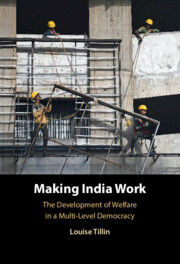Book contents
- Making India Work
- Making India Work
- Copyright page
- Dedication
- Contents
- Illustrations
- Acknowledgments
- Abbreviations
- 1 Introduction
- 2 Origins, Expansion, and Reform
- Part I Building a National Economy: Regulating Internal Competition
- 3 In the Shadow of Sickness
- 4 World War II, Tripartism, and a National Welfare State for Industrial Workers
- Part II Putting India to Work
- Part III Liberalisation and Welfare in a Multi-level Democracy
- Bibliography
- Index
3 - In the Shadow of Sickness
Bombay and the Origins of Social Insurance
from Part I - Building a National Economy: Regulating Internal Competition
Published online by Cambridge University Press: 13 February 2025
- Making India Work
- Making India Work
- Copyright page
- Dedication
- Contents
- Illustrations
- Acknowledgments
- Abbreviations
- 1 Introduction
- 2 Origins, Expansion, and Reform
- Part I Building a National Economy: Regulating Internal Competition
- 3 In the Shadow of Sickness
- 4 World War II, Tripartism, and a National Welfare State for Industrial Workers
- Part II Putting India to Work
- Part III Liberalisation and Welfare in a Multi-level Democracy
- Bibliography
- Index
Summary
This chapter is the first of two focused on the period between 1919 and 1947 bookended by, on the one hand, India’s membership of the new International Labour Organisation in 1919 and, on the other, the birth of independent India in 1947. Together these chapters chart the origins of a social insurance-led model for a future Indian welfare state directed towards an industrial working class. The chapter also documents how - facing rising industrial unrest - the newly elected provincial government of Bombay, the historic centre of India’s textile industry, began to experiment with social insurance. Limited decentralisation under successive Government of India Acts had provided greater autonomy to provinces in the field of labour policy. Bombay was the first to introduce maternity benefits. It then became the first to support sickness insurance for industrial workers as a means of labour force stabilisation. However, given fierce inter-regional competition within India’s textile industry, the adoption of sickness insurance did not proceed because without national coordination Bombay would have been disadvantaged in competition with regions without labour regulation.
Keywords
- Type
- Chapter
- Information
- Making India Work , pp. 45 - 76Publisher: Cambridge University PressPrint publication year: 2025

